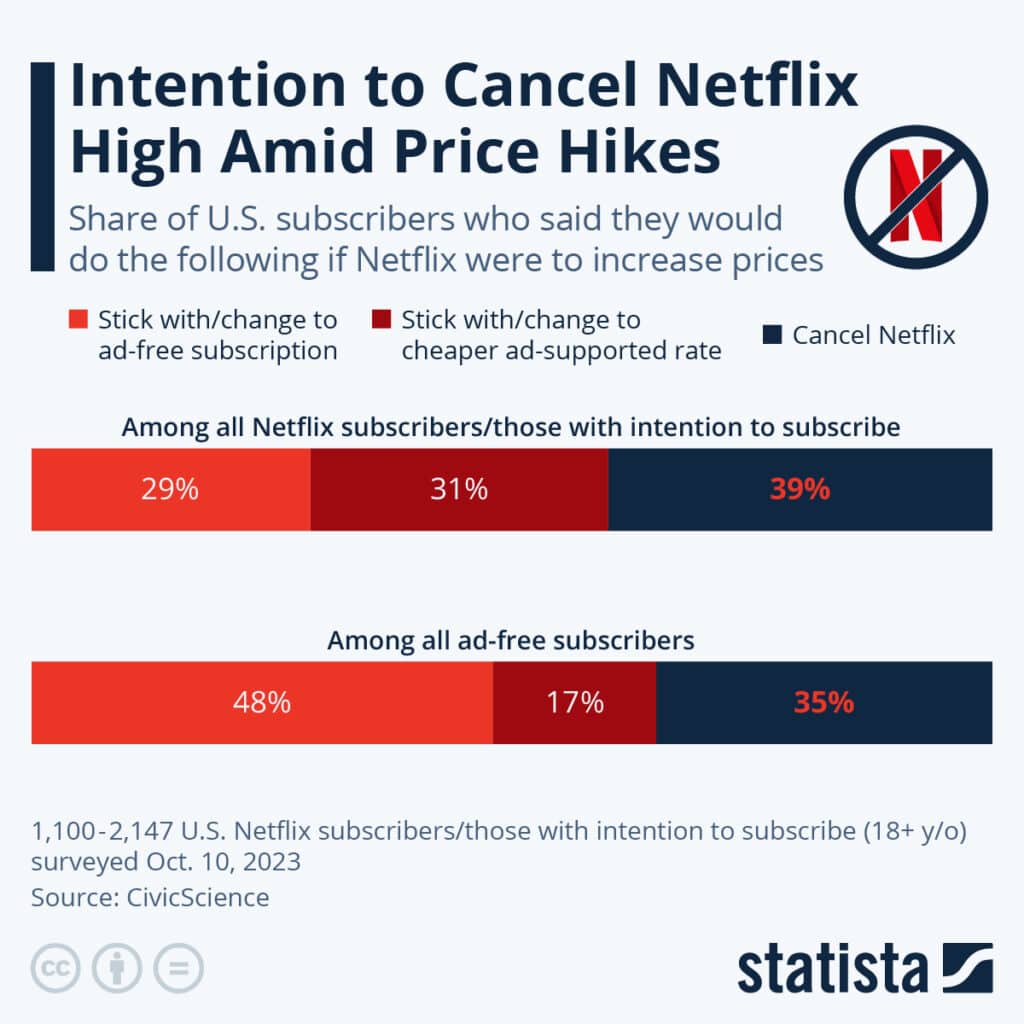
Five on Friday: Netflix Cancels, Changing News Consumption, MegaTrends, and More
Welcome to “Five on Friday”! We cover themes of pricing, user behaviors, technology evolution, trust, data privacy, and adapting to market changes this week. We explore: how Netflix users are reacting to the potential price; the changing landscape of news consumption, especially among younger audiences; Meta’s introduction of European ad-free subscriptions and the implications for user privacy; eight mega trends that are reshaping the future; and finally, Google’s exploration of subscription models for its AI services, marking a strategic shift for the tech giant.

Netflix Users Ready to Cancel Subscriptions Over Potential Price Hike: Study
Netflix, one of the world’s leading streaming platforms, has recently raised concerns among its users by announcing a forthcoming price hike for its ad-free subscription tier. While the company has not disclosed the exact amount or the timing of the increase, a new study conducted by CivicScience has shed light on how Netflix subscribers are likely to react to this change. The study, which collected responses from approximately 4,000 participants on October 10, provides insights into consumer sentiment regarding this potential price increase.
The survey uncovered several key findings:
- Cancellation Intent: Nearly 39% of respondents indicated that they would consider canceling their Netflix subscription entirely if the price of the ad-free tier were to increase. This highlights the sensitivity of subscribers to changes in pricing.
- Ad-supported Subscription: In the event of a price increase, 31% of participants expressed their willingness to switch to a lower-cost subscription plan that includes advertisements, indicating a preference for ad-supported content over higher fees.
- Loyalty to Ad-Free Tier: Despite the potential increase, 29% of respondents would continue with their ad-free subscription, reflecting a group of subscribers willing to pay more for an uninterrupted streaming experience.
- Ad-Free Subscribers’ Reaction: When analyzing the responses of existing ad-free subscribers, 35% of them considered canceling their Netflix subscription, while 17% opted to downgrade to the ad-supported tier. An encouraging 48% of this group remained committed to the platform despite the higher fees.
The Netflix price hike is expected to take effect after the SAG strike concludes and is anticipated to begin in the United States and Canada. In the US, Netflix’s standard plan (offering two streams and no ads) currently costs $15.49 per month, while the Premium tier (providing four streams) is priced at $19.99 per month. Netflix last adjusted its prices in January 2022.
This year, Netflix took measures to address password-sharing among users, which resulted in a significant uptick in new subscribers. To add members to their account, users are now required to pay extra fees, an initiative that attracted 5.9 million new subscribers globally since its introduction in March.
The study’s findings underscore the importance of pricing strategies for streaming platforms like Netflix, especially within a competitive market. As the platform prepares to implement its price increase, it must carefully consider the potential ramifications on its user base. Subscribers’ willingness to consider canceling their subscription or downgrading to ad-supported plans indicates that pricing changes can significantly influence consumer behavior in the streaming industry. Netflix will likely monitor these developments closely as it navigates the evolving landscape of online streaming and subscription-based entertainment services.

The Changing Landscape of News Consumption:
The Washington Post has an insightful analysis of how content creators are surging past legacy news providers leveraging platforms like TikTok and Instagram to reach young audiences, impacting how they are consuming their news. The lesson here is that younger audiences prefer consuming news through more accessible and engaging formats, including:
- Desire for Relevance and Informality: Independent content creators have captured the attention of audiences by delivering news in informal, relatable, and entertaining ways. The traditional, formal presentation of news has given way to influencer-driven content that feels more relevant.
- Influence of Independent Creators: Independent content creators have proven to be influential and impactful in the world of news. Many of these creators amass larger followings than established media outlets, especially when catering to underserved communities. The lesson here is that these creators can shape public opinion and the news agenda effectively.
- Economic Shifts in Journalism: The rise of independent content creators has caused economic shifts within the journalism industry. While some established news outlets have expanded their digital presence, others have struggled. Advertisers increasingly invest in creators, leading to financial challenges for traditional media. This shift highlights the need for adaptability in the rapidly changing media landscape.
- A More Diverse Media Ecosystem: Independent content creators have fostered a more diverse media ecosystem. This has allowed a wider array of voices to challenge narratives, providing consumers with fresh perspectives. However, it has also led to concerns about the credibility and reliability of information sources.
- Challenges in Responsible Reporting: Not all content creators follow the same ethical guidelines as traditional newsrooms. Some creators build their audiences on outrage, potentially contributing to the spread of misinformation. This lesson emphasizes the importance of responsible and accurate journalism in the age of digital news.
- Emergence of Conservative Platforms: Conservative audiences have found new platforms like Rumble, BitChute, and Telegram, where they can monetize content and attract like-minded individuals. This shift reflects the evolving dynamics of online media consumption, further fragmenting the media landscape.
- Challenges for Traditional News Outlets: Established media institutions face challenges in maintaining trust, particularly among younger audiences. While these outlets still produce original reporting, there is growing skepticism towards their impartiality. Content creators aim to fill the gaps and cater to niche audiences with unique perspectives.
- Quality Journalism Remains Vital: Despite the changing media landscape, quality journalism remains essential. Content creators often rely on reporting from traditional sources. There is a need for a strong foundation of trustworthy journalism that ensures the quality and accuracy of the information available to the public.
- Credibility with the Audience: Content creators with roots in traditional journalism prioritize meticulous reporting and fact-checking. Building trust directly with the audience is crucial. This lesson underscores the significance of credibility, especially in an era of low trust in mainstream media.
In conclusion, the rise of independent content creators in the news sphere is a testament to the evolving media landscape. Lessons from this shift highlight the changing preferences of audiences, economic challenges for traditional media, and the importance of responsible journalism. While the news ecosystem continues to transform, the core principles of quality reporting and credibility remain paramount in ensuring a well-informed public.
Read more here.

Meta Introduces European Ad-Free Subscriptions, Raises Questions About Data Privacy
Meta, the parent company of Facebook and Instagram, has introduced a subscription option for users in about 30 European countries. This subscription, priced at approximately $10.60 per month initially and increasing to around $17 per month early next year, allows users to access these social media platforms without ads. While it’s seen as a move to comply with tightening European regulations, some argue that it raises questions about user privacy and data collection, as Meta will continue to gather user data from subscribers. This development also poses the larger question of whether people are willing to pay to avoid data-driven advertising.
In Europe, users have traditionally been able to limit the information used by Meta for targeted ads, but now they can completely opt out of ads. However, this move may not entirely satisfy regulators. While some users may be willing to pay for an ad-free experience, it brings to the forefront concerns about the data collection practices of major tech companies. Critics argue that companies should collect less data on everyone, regardless of their willingness to pay for ad-free services. This development might prompt discussions about internet privacy and whether similar subscription options will be made available to users in other parts of the world.

8 Mega Trends To Understand Now
According to Forbes, the future is on the brink of a transformative revolution and outlines mega Trends we all need to understand where connectivity knows no bounds, technology reaches new frontiers, industries redefine their role in society, and energy becomes decentralized and potentially free. Here are the MegaTrends:
- Hyper-Connected World: The evolution of connectivity, from 3G to 6G, is expected to create a unified and hyper-connected living ecosystem. The integration of satellite networks and high-speed broadband will enable constant connectivity, paving the way for new disruptive business models.
- Dawn of Technology Singularity: The progression from narrow AI to General AI and, eventually, to Super AI is a major trend. The emergence of technologies like Neuromorphic Computing and Quantum Computing will challenge Moore’s law and accelerate the shift toward Super AI, potentially surpassing human intelligence.
- Industry 5.0 – The Symbiotic Era: Industry 5.0 goes beyond efficiency and productivity, emphasizing the role of industry in society. It foresees human-robot co-working reshaping jobs, skills, and global sourcing, much like previous industrial revolutions transformed society.
- The Energy Transition: The future of energy involves decarbonization, decentralization, digitalization, and democratization. These shifts are expected to lead to energy that is potentially free, offering unique business models and opportunities that differ from the current energy landscape.
- Innovation to Zero: This vision encompasses the pursuit of a perfect world with zero crimes, diseases, hunger, and carbon-neutral entities. It promotes safety, sustainability, and the elimination of errors and defects across all aspects of life.
- Future of Mobility: The future of travel will be faster and smarter, with multi-modal, integrated systems providing real-time dynamic guidance and energy-efficient transport. It envisions a world where congestion, pollution, and accidents are eliminated, and sub-surface and super-surface travel with hypersonic speeds becomes a reality.
- Future Society and Urbanization: The changing demographics, urbanization trends, and growth of small and intermediate-sized cities, especially in Asia and Africa, will lead to diverse and personalized service requirements. These trends will drive the development of new markets, products, and services.
- Economic Powerhouses of the Future – Baby-Bust Economies: Emerging economies with growing populations are set to outpace advanced economies in growth. Countries with populations exceeding 100 million have the potential to become trillion-dollar economies by 2040. The global economic landscape is evolving, with the aspirations and economic contributions of developing countries shaping a potentially unpredictable yet exhilarating future.
These 8 Mega Trends offer a glimpse into a future characterized by unprecedented connectivity, technological advancements, changes in industry and energy, a quest for perfection, innovative mobility solutions, shifting societal dynamics, and the rise of new economic powerhouses to think about and plan for.

Google Explores Subscriptions for AI Services
Google’s potential exploration of subscription models for its AI services represents a strategic shift as it seeks to diversify revenue sources beyond advertising. The success of YouTube’s subscription-based services appears to be a motivating factor, and this development may have significant implications for the future of Google’s product portfolio and its revenue composition. However, it is evident that Google is proceeding cautiously, given the potential impact on its lucrative advertising business.
According to Business Insider, Google CEO Sundar Pichai mentioned during the earnings conference call the possibility of adopting subscription business models for certain AI products. Pichai highlighted the ongoing evolution of Google’s Search and Google Assistant services over the next decade, indicating the central role of AI in shaping the future of these products. This suggests Google’s intent to harness AI to enhance user experiences and service offerings.
Google’s investments in AI, particularly in products like Search Generative Experience (SGE) and Google Bard, are of interest to Wall Street analysts. They are looking for signs of higher utility, conversion rates, and engagement to assess the potential returns on these investments.
The most significant point is Google’s consideration of subscription models for its AI services. This move aligns with the success of YouTube’s subscription-based services, including YouTube TV and NFL Sunday Ticket. Google’s “other” revenue, largely driven by YouTube subscriptions, grew by 21% year-on-year in the third quarter, reflecting the potential of subscription-based AI offerings.
Google’s core business is advertising, and Search ads contribute significantly to its revenue and profit. Any substantial changes to the Search experience, especially if it becomes more AI-driven like ChatGPT, could impact the performance and appearance of these ads. The cautious approach Google is taking in this context is understandable, considering the implications for its advertising-based revenue.
- Filed in Assocations, Auto-renew Subscription, Business Media and Publishing, Business Services, Business Strategy, Clubs, Consumer Media and Publishing, Consumer Services, Data and IoT, Direct-to-Consumer, Entertainment and Streaming, Industry Announcements, Learning and Training, Magazines, Memberships, News, Newsletters, Paywall, Pricing, Regulation and Compliance, Research and Benchmarks, SaaS and Cloud Services, Subscription Apps, Subscription Boxes, Subscription Gaming





